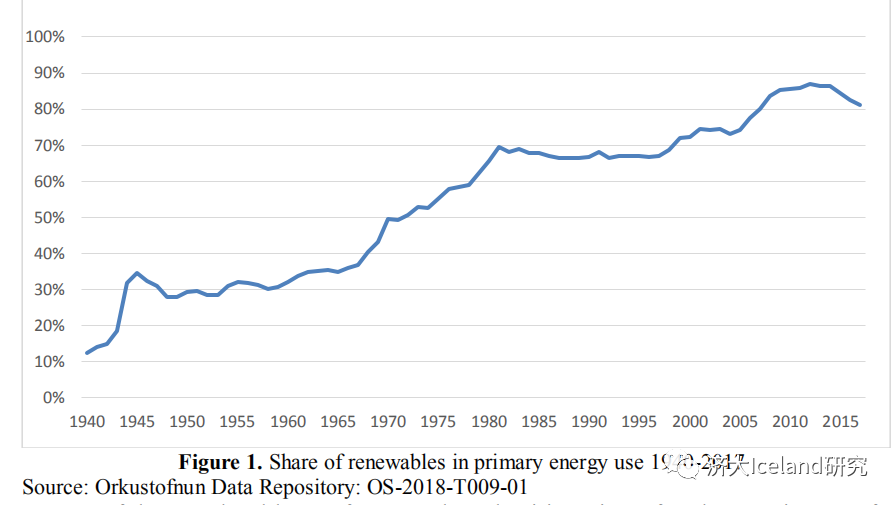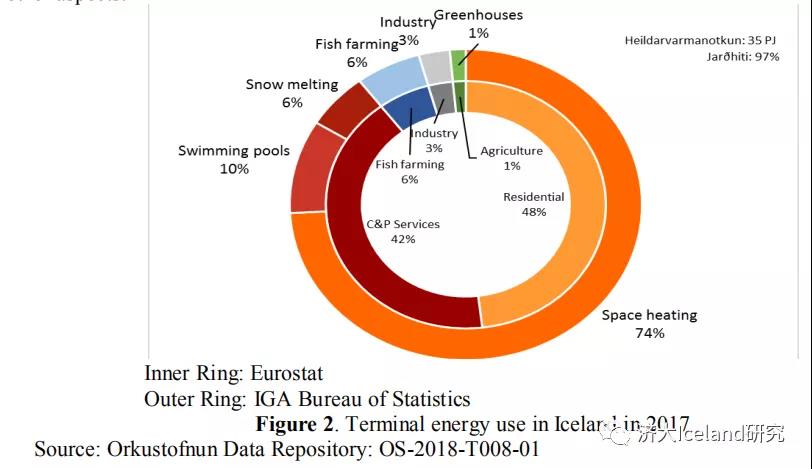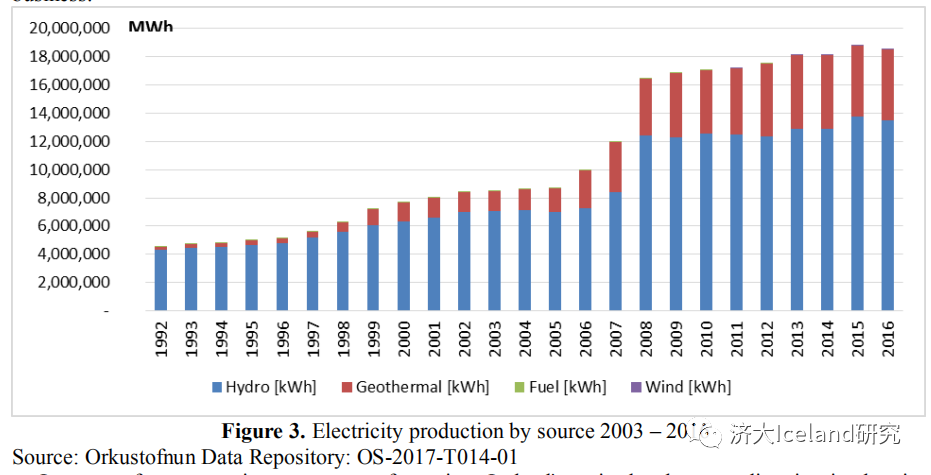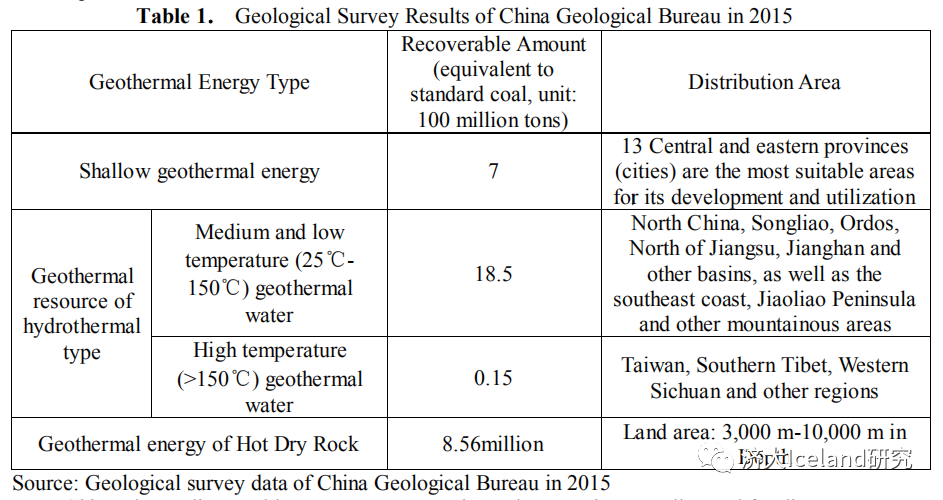Study on the Exploitation, Utilization and Cooperation of Geothermal Energy between Iceland and China
Huan Zhang1,2, Wei Meng1 and Fang Zhao1,3*
1Business School, University of Jinan, Jinan 250002, Shandong, China
2Iceland Research Centre, University of Jinan, Jinan 250022, Shandong, China 3Shandong Longshan Green Economy Research Centre, Jinan 250022, Shandong, China
*corresponding author’s e-mail: se_zhaof@ujn.edu.cn
Abstract. Iceland has a long history of geothermal resource utilization and gains successful experiences in the exploitation and management of geothermal resources. Although China has abundant geothermal resources, the utilization rate is not high, and its management mechanism is not perfect yet. There is still much toimprove. Through the comparison of geothermal resource utilization and management between Iceland and China, combining with the evolutionary gamemodel of energy cooperation, this paper draws a conclusion: although both sides can gain corresponding benefits by strengthening energy cooperation, the urgency of cooperation between them is not very strong and the cooperation is in a still mode. With the increasing proportion of China's clean energy usage and pressure on traditional energy security, as well as the promotion of China-Iceland free trade zone in bilateral economic and trade cooperation, their willingness forenergy cooperation is very likely to be strengthened. Therefore, both sides should be forward-looking when formulating energy strategies, establish a geothermal enterprise alliance, share knowledge and information, actively deepen the co-development of unconventional geothermal energy.
1. IntroductionFacing the pressure of climate change and energy shortage, every country is constantly trying to explore, exploit and utilize the clean energy to achieve sustainable development. Geothermal energy, a kind of clean energy, is abundant in reserves, which has gradually become the key in new-energy research and development. As one of the countries that have most abundant geothermal resources in the world, Iceland has taken the lead in the geothermal-energy exploitation and research. Although China’s geothermal resources are rich as well, accounting for approximately one-sixth of the global resources, its proved resources rate and utilization level of the resources are still low. Its exploitation and utilization of geothermal resources are still need to be improved. The purpose of this paper is to compare the current situation, prospect and management mechanism of geothermal resources between Iceland and China, meanwhile, analyze their mode of cooperation as well as explore their next path of geothermal-resource cooperation in the future.
2. Current Status of the Geothermal-Resource Exploitation and Utilization in Iceland
Iceland is geologically located at the boundary between the Eurasian plate and the North Americanplate, and on the mid-Atlantic ridge expansion belt. Its unique geographical location and structuremake Iceland rich in geothermal resources. But Iceland didn't enter the renewable-energy dominated era at the very beginning. It has also experienced a fossil-powered era that dominated by the oil and the coal. As a result of the comprehensive effects of internal and external factors, Iceland hasundergone a long period of energy transformation, which led to a new pattern of renewable-energydominated utilization (see Figure 1).

Because of the natural and human factors such as the rising prices of coal energy imports after World War I, the bad weather in Iceland, the 1973 oil crisis and the climate change in the 1990s, Iceland has accelerated its energy transformation and promoted its usage and development of the geothermal resources (He Jijiang, 2017). According to the data from the Orkustofnun database, Iceland's use of geothermal energy accounted for about 60.7% of its primary energy use by 2017, suggesting that Iceland's use of geothermal energy has gone to the extreme. The use of geothermal energy in Iceland can be roughly divided into direct use and indirect use. The direct use is very extensive, not only for heating, but also for snow melting, fishing, farming, industry, greenhouse and other aspects.

The indirect use of geothermal energy in Iceland mainly refers to geothermal power generation.Iceland has begun to utilize the geothermal energy to generate electricity long time ago. Iceland mainly relies on hydropower and geothermal power currently, and the proportion of geothermal power has grown steadily in recent years (see Figure 3). However, due to the technical problems such as hightemperature, acid corrosion and toxic hydrogen sulfide gas in geothermal power generation, only about 17% of Iceland's geothermal energy is used to generate electricity. But there is still great potential in geothermal power generation. According to the data from ThinkGeoEnergy, until July 29, 2019, the global installed capacity had reached 14,900 MW, with Iceland's installed capacity of 755 MW, ranking the ninth largest in the world. The cost of geothermal power energy in Iceland is very low, if converted into RMB, the average industrial electricity price is less than 0.2 RMB yuan/kWh. There are still many resources available for the construction of geothermal power stations. However, due to the local electricity loads, they have not been fully developed. Besides, Iceland is also considering further expanding the scale of the aluminum industry or building an offshore UHV transmission line from Iceland to the UK to further boost the island's geothermal-power generation business.

In terms of transportation energy transformation, Iceland's main development direction is electricvehicles. Due to Iceland's unique geographical environment and its urban layout, the Icelandicgovernment is committed to developing electric vehicles and charging stations in the capital Reykjavik, utilizing geothermal power and hydropower to realize the application of electric vehicles.Simultaneously Icelandic government imposes high taxes on fuel to curb citizens' demand for gasoline.Ever since the government started to implement the relevant strategies of encouraging the development of electric vehicles, Iceland's geothermal companies see the opportunities ahead. They are trying to explore carbon capture technology, converting carbon dioxide into methanol through the chemical reaction to replace diesel and other fuels so as to realize nearly zero carbon of transportation energy. Iceland will continue to make efforts to achieve zero carbon dioxide emission of transportation energy and realize the transformation of transportation energy.
3. Exploitation and Utilization of Geothermal Energy in China
Different from Iceland, China's geothermal resources are dominated by medium and low temperature,supplemented by high temperature. According to a geological survey and evaluation conducted byChina Geological Survey Bureau during the 12th Five Year Plan period (Table 1), the exploitableamount of shallow geothermal energy in 336 cities above prefecture level in China is equivalent to 700million tons of standard coal, realizing 32 billion square meters of heating and cooling. The annualexploitable resources of geothermal water is equivalent to 1.9 billion tons of standard coal, of whichthe annual exploitable resources of medium and low temperature (25℃ - 150℃) geothermal water are1.85 billion tons of standard coal. The annual exploitable resources of high temperature (>150℃)geothermal water are equivalent to 15.3 million tons of standard coal. The land-based hot and dryprospect resources amount to 856 trillion tons of standard coal. According to the international Hot DryRock standard, with 2% as the recoverable amount, it is about 4,000 times of the total energyconsumption of China in 2015.

In China, the medium and low temperature geothermal energy is generally used for direct purposes,mostly for heating and cooling, industry, planting and breeding, hot spring tourism and other aspects. Moreover, the direct utilization of geothermal resources in China has ranked first in the world for many years continuously. According to the Report on the Development of Geothermal Energy inChina (2018), the direct utilization of shallow geothermal energy as well as middle and deepgeothermal energy in China has maintained a rapid growth rate of 28% and 10% respectively.According to the data of the world geothermal congress in 2015, the direct utilization of geothermalenergy in China reached 48,435GW·h, among which heat pumps accounted for 58%, middle and deepgeothermal heating accounted for 19%, hot spring bathing accounted for 18%, and cultivation andbreeding accounted for 5%.
High temperature geothermal resources are mainly used to generate electricity, but the development of geothermal power in China is slow. At the end of 2014, the installed capacity of geothermal power in China was 27.28 MW, ranking the 18th in the world, accounting for only 0.2% of the global installed capacity. China has formed a pattern of development and utilization in the way of utilization, with geothermal power generation represented by Yangbajing in Tibet, geothermal heating represented by City of Tianjin, Shaanxi Province and Hebei Province, heating and cooling of the shallow water source heat pump represented by City of Shenyang, heating and cooling of the sea water source heat pump represented by City of Dalian, recuperation and tourism represented by Beijing and southeast coast, as well as planting and breeding represented by the North China Plain (Zhou Zongying, 2015).
4. Comparison of the Geothermal Management System between China and Iceland
4.1. Iceland Geothermal Management System
The exploration, exploitation and utilization of geothermal energy in Iceland are subject to the unifiednational management, including the National Energy Authority, Iceland GeoSurvey and the energycompanies in charge of different affairs each. The national energy administration is mainly responsiblefor the government consultation and policy formulation, providing policy basis for the exploitation andutilization of geothermal resources and standardizing the utilization order. Iceland GeoSurvey (ISOR)is a new consulting and research department which was later divided from the National EnergyAuthority. Energy companies are responsible for the entire utilization process of the country'shydropower and geothermal resources, from exploration to operation. On the legal level, to promotesustainable development of the geothermal resources, Iceland has launched a series of laws, includingthe Research and Utilization of the Underground Resources, Nature Protection Law, Law onEnvironmental Impact Assessment, Energy Law, the Ground Energy Survey and Utilization Act, and so on. The laws clearly state the ownership of geothermal resources, that is, the ownership of resources belongs to the ownership of lands. In addition, the different processes of exploiting and utilizing the geothermal resources are explained by relevant laws and are subject to different laws.
4.2. China's Geothermal Management System
China has paid close attention to geothermal resources in recent years and has basically established amanagement system for geothermal resources, which includes exploration permits, mining permits,well drilling approvals, drilling and construction supervision, public assignments of mining rights,record-keeping of working units, resource protection, scientific and technological project managementetc.. From the prospective of the law, the management of geothermal resources is restricted, and theorder of exploration, development and utilization of geothermal energy is well maintained. At thenational level, the Water Law of the People's Republic of China, the Law of the People's Republic ofChina on Mineral Resources and the Renewable Energy Law of the People's Republic of China allinvolve geothermal resources, managing the geothermal resources from the perspectives of licensingsystem and paid use system for water intake, resource tax and resource compensation, as well asrenewable energy etc.. In addition, China has established two institutions. One is National Center forthe Exploitation, Research and Application of Geothermal Energy. The other one is TechnicalCommittee for the Standardization of Geothermal Energy in the Energy Industry, which promotes therapid and orderly development of the geothermal industry. At the local level, based on Water Law,Mineral Resources Law and Renewable Energy Law, all provinces and cities refine the nationalpolicies and regulations, and manage the geothermal resources of local regions according to theirregional characteristics. For example, the governments of Beijing, City of Tianjin, Hebei Province,Yunnan Province, Inner Mongolia and City of Chongqing have promulgated and implemented laws and regulations on the exploitation and utilization of local geothermal resources, managing localgeothermal resources in a more targeted way. Nonetheless, since the national government has no clearand authoritative definition of geothermal resources, three laws at the national level give geothermalresources triple attributes to the water resources, mineral resources and renewable energy, which leadto multi-management and relevant problems.
At present, geothermal resource management organizations of local governments in China are set up in the Departments of Natural Resources, Water Resources and Housing and Urban-Rural Development, emphasizing different attributes of geothermal resources respectively. Different organizations manage geothermal resources in accordance with their respective laws. The Natural Resources Department manages them from the resource attribute of geothermal resources, while the Water Resources Department restricts them from the water resource attribute. Department of housing and Urban-Rural and Department of Ecology and Environment pay more attention to the approval process of geothermal resources exploitation and utilization. This phenomenon leads to issues like multiple cross management and duplicating charging in the geothermal exploitation and utilization. In this regard, although some Bureaus of Geology and Mineral Exploration in several provinces and cities have responded to the questions or requests about the geothermal-resource management in the province, due to the low legal effect, the issue of cross management cannot be dealt with effectively. It is still necessary for the national to publish relevant laws as soon as possible, clarifying the definition of geothermal resources and the management organization of geothermal resources.
5. China-Iceland Energy Cooperation
The formulation of energy cooperation strategies between countries cannot be done without thecomprehensive analysis on the cooperative environment and conditions. Therefore, evolutionary gamemodel of energy cooperation will be used in the following to analyze the energy cooperation path ofChina-Iceland.
5.1. Evolutionary Game Model of Energy Cooperation
According to Hu Jianhui (2017), the energy cooperation strategies between countries are affected bythe economic benefits, security benefits and cooperation costs of the cooperation between the twosides. The net income of a country's choice of cooperative or non-cooperative strategies is affected byother countries' strategies. Therefore, the payment matrix of the energy cooperation game between thetwo sides is as follows:

𝑈𝐸𝑖(𝑋, 𝑌) is the expected utility function of the action country i in the state ofnoncooperation;𝐸𝑖(𝑋,𝑌) is the residual income obtained by the cooperation of action country i; 𝑈𝐸𝑖(𝑋, 𝑌)represents the benefits that can be obtained when the action country i chooses not to cooperate;Ci(X,Y) is the cost of seeking cooperation for country i; 𝜆𝑖is the coefficient of containment effect of residual income from cooperation of country j on country i, representing the relative benefit distribution of the two sides in the cooperation.
The decision of whether a country cooperates with other countries in energy is the result of thecontinuous game of multiple groups in the domestic contry. The attitude of a country towards thecooperation is not simply attributed to “cooperation” or “noncooperation”, but often a trend (HuJianhui, 2017). The strategic mode of energy cooperation adopted by one country with another depends on the urgency of cooperation, which is up to the benefits (including absolute and relative benefits) and the cost of cooperation.
According to the game model of national energy cooperation, the decision-making situation of acountry can be divided into four categories according to the urgency of the cooperation, as shown inthe following table:

5.2. China-Iceland Energy Cooperation Path
China's energy security situation has become grim. In 2016, China's dependence on oil and natural gas reached 64.1% and 33.5% respectively (Chen Xianliang, 2017). Under the pressure of traditionalenergy security and ecological environment protection, China has been actively promoting the use ofUrgency Level of the Other PartyDomestic Urgency LevelHigh LowHigh Turbulence UrgencyLowDisturbance Calmnessclean energy and renewable energy. It is estimated that the proportion of renewable energy will increase from 3% in 2017 to 18% in 2040 (BP World Energy Outlook, 2019). Iceland has a long history of geothermal development, and its geothermal utilization technology has the characteristics of simple in technology, low in cost, and great in results. Therefore, China hopes to promote the development and utilization of the related energy with the help of mature technologies of renewable energy such as geothermal and hydrogen energy in Iceland. The geothermal enterprises in Iceland have already developed very advanced technology to exploit the geothermal resources. However due to the small local population, the geothermal resources developed and utilized can basically meet the local demand, so the development of domestic geothermal industry has been hindered. Iceland hopes to share the dividend of China's rapid economic growth through the renewable energy technology cooperation with China, so as to strengthen all-round cooperation between the two countries in economic and trade fields.
However, at present, the proportion of renewable energy in China's energy utilization is stillrelatively low. Iceland also has a wide range of options for energy partners, and its interest relationshipwith China is not close in terms of both economic and national security energy strategies. Therefore,although both sides can gain corresponding benefits from strengthening energy cooperation, theurgency of cooperation between both sides is not very strong and it is in a still mode. In this situation,the cooperation between the two sides is mainly at the folk level such as enterprises. For example,United Nations University and relevant Icelandic authorities collaborated and established GeothermalTechnology Training Project. Since 1979, a geothermal technology training course has been held inReykjavik to train geothermal technicians for developing countries. Since the 1980s, 80 Chinesegeothermal technicians have received training in Iceland. On December 2, 2019, China-IcelandGeothermal Training Project sponsored by National Geothermal Energy Development & ApplicationResearch Centre, Iceland National Energy Authority and Arctic Green Energy Corporation wasunveiled in Beijing, implementing by Sinopec Star Co., Ltd.. In November 2006, Sinopec Star Co.,Ltd. and Arctic Green Energy Corporation established Sinopec Green Energy Geothermal Development Co., Ltd. together, which is engaged in the comprehensive development and utilization of geothermal resources, energy-saving technical services, greenhouse gas emission reduction and other businesses. It has developed geothermal projects in several cities and counties in China, covering Beijing, Hebei Province, Shandong Province, Shaanxi Province and some other places. In recent years, Xiong County model and Wugong smokeless city have been successfully built in Xiong County, Hebei Province and Wugong County, Shaanxi Province, promoting the technical progress of thermal storage and reinjection of middle and deep hydrothermal sandstone. In addition, Sinopec Green Energy Geothermal Development Co., Ltd. has been committed to the development of new geothermal projects, and has carried out new projects in City of Jinan, City of Dezhou and other places in Shandong Province. In August 2017, Sinopec Green Energy Geothermal Development Co., Ltd. signed a geothermal resource development and utilization agreement with Qihe County, City of Dezhou. The lithology of Qihe County is primarily Ordovician limestones, which are mainly karst fissure type thermal reservoir. It is very easy to replicate and promote the Xiong County model in Shandong Province. In March 2018, Sinopec Green Energy Geothermal Development Co., Ltd. signed a strategic cooperation agreement with Shandong Shanghe State Investment Group on geothermal development to further development of geothermal resources of Shanghe. Sinopec Green Energy Geothermal Development Co., Ltd. integrates Sinopec's capital, government support, reputation and the key technologies of Icelandic AGEC. It is committed to developing China's geothermal resources and improving the utilization efficiency of China's geothermal resources. By December 2019, Sinopec Green Energy Geothermal Development Co., Ltd. has reduced emissions of 7.5 million tons of carbon dioxide for the society. In December 2016, China and Iceland established a Geothermal Technology R & D Cooperation Center in Beijing. In 2018, the two countries signed a Memorandum of geothermal Working Group, providing a new platform for bilateral cooperation. The two sides also achieved breakthroughs in the cooperation of new energy field. In July 2015, Geely Holding Group of China invested in Carbon Recycling International (CRI), promoting the clean energy and methanol vehicles. The cooperation between the two sides continues to deepen.
With the increasing proportion of China's clean energy usage and pressure on traditional energysecurity, as well as the promotion of China-Iceland free trade zone in bilateral economic and tradecooperation, their willingness for energy cooperation is very likely to be strengthened. Therefore,China should be forward-looking and strive for initiative in energy cooperation with Iceland.
6. Conclusion and Suggestion
Through sorting out the development, utilization and management of geothermal resources in Icelandand China in recent years, this paper finds that the utilization rate of geothermal resources in Iceland isrelatively high. The exploitation technology is advanced, taking the lead of the world. Iceland willcontinue to focus on the transportation-energy transformation and the R&D of unconventionalgeothermal technologies in the future. China's geothermal resource reserves are huge. In recent years,China has begun to pay attention to the development and utilization of clean resources, including thegeothermal energy. China has basically formed a trend that rapidly developing the shallow geothermalenergy utilization, meanwhile steadily increasing the hydrothermal geothermal energy utilization.Simultaneously, the industrial system of geothermal resources for exploration and development of dryhot rock geothermal energy has begun to take shape. However, there are still some deficiencies in theexploitation and utilization of geothermal resources in China, such as the slightly behind keytechnologies and the imperfect management mechanism. According to our research, there aresignificant complementarities in the exploitation and management of geothermal resources as well asenormous possibilities for cooperation between China and Iceland in the future. Based on the analysison the evolutionary game model of energy cooperation, it is concluded that it is necessary to strengthen the cooperation and exchange of geothermal resources between China and and Iceland. We suggest the two sides should establish a geothermal enterprise alliance, cooperate in the development of China's heating projects and geothermal power stations, share knowledge and information, accelerate the joint R&D of unconventional geothermal energy technology and then benefit people of both countries as well as the whole world.
Acknowledgement
This work is supported by Research Program of Iceland Research Centre, University of Jinan (Titled:The Study on the Reality and Path of China-Iceland Energy Cooperation) and horizontal project(Titled: The Study on Energy Policy Optimization to Effectively Improve Environmental Protection Effects) of Shandong Academy of Macroeconomic Research. We deeply appreciate the valuable comments of the anonymous referees.
References
[1] Zhang Y and He W W 2019 The direct utilization of middle-shallow geothermal energy in China has ranked first in the world for many years Retrieved fromhttp://www.ce.cn/cysc/ny/gdxw/201910/15/t20191015_33342257.shtml
[2] He J J 2017 Iceland's energy transition (part 1) J. Wind Energy pp 12-5
[3] He J J 2017 Iceland's energy transition (part 2) J. Wind Energy pp 12-4
[4] Wu X M, Bai Q and Yuan H M 2007 Development and utilization of geothermal resources inIceland J. Hydrogeology & Engineering Geology pp 1-2
[5] Li X F, Wang J and Sun J 2014 The enlightenment of Iceland's geothermal resource management to China's geothermal development J. Conservation and Utilization of Mineral Resources pp 6-9
[6] Ingvar B and Fridleifsson 2002 Geothermal Development in Iceland and China Proc. Int. Conf.on Geothermal (Beijing: Geological Publishing House)
[7] Fan J J and Fan H X 2017 Sideline of the national seminar on the survey and evaluation ofgeothermal resources by China geological survey Retrieved from
http://www.cgs.gov.cn/zdjh/gtkf/xmjz/201712/t20171205_446498.html
[8] Zhou Z Y, Liu S L and Liu J X 2015 Characteristics and development countermeasures ofgeothermal resources in China J.Journal of Natural Resources pp 1210-21
[9] Hu J H 2017 Sino-Russian Energy Cooperation Strategy under the Perspective of National Security(Beijing: People’s Daily Press)
[10] Chen X L 2017 China's energy security and China-Russia energy cooperation J. Northeast AsiaForum | Northeast Asia Forum pp 61-73+129-130
[11] Dai B H 2017 Thinking on the exploitation and utilization of geothermal resources and strategiclayout in China J. Green Petroleum&Petrochemicals pp 6-12
[12] Dong L 2019 A brief analysis on the management mechanism of geothermal energy development and utilization in China J. Construction Science and Technology pp 14-9+27